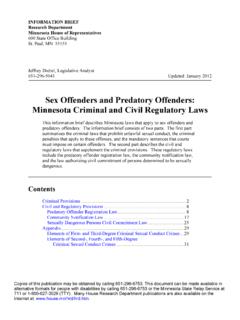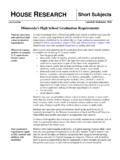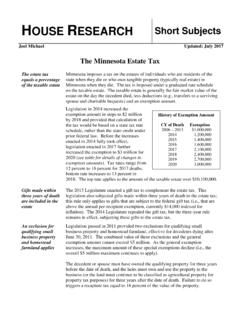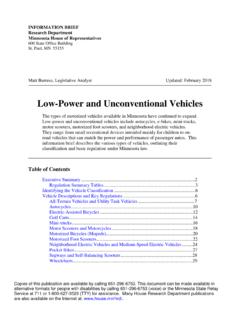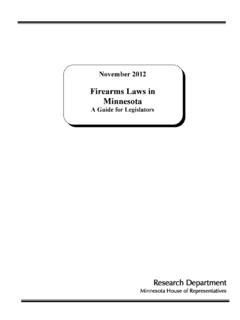Transcription of Sex Offenders and Predatory Offenders: Minnesota Criminal ...
1 INFORMATION BRIEF. Research Department Minnesota House of Representatives 600 State Office Building St. Paul, MN 55155. Jeffrey Diebel, Legislative Analyst 651-296-5041 Updated: January 2012. Sex Offenders and Predatory Offenders : Minnesota Criminal and Civil Regulatory Laws This information brief describes Minnesota laws that apply to sex Offenders and Predatory Offenders . The information brief consists of two parts. The first part summarizes the Criminal laws that prohibit unlawful sexual conduct, the Criminal penalties that apply to these offenses, and the mandatory sentences that courts must impose on certain Offenders . The second part describes the civil and regulatory laws that supplement the Criminal provisions. These regulatory laws include the Predatory offender registration law, the community notification law, and the law authorizing civil commitment of persons determined to be sexually dangerous. Contents Criminal Provisions .. 2 Civil and Regulatory Provisions.
2 8 Predatory offender Registration Law .. 8 Community Notification Law .. 17 Sexually Dangerous Persons Civil Commitment Law .. 25 Appendix .. 29 Elements of First- and Third-Degree Criminal Sexual Conduct Crimes .. 29 Elements of Second-, Fourth-, and Fifth-Degree Criminal Sexual Conduct Crimes .. 31 Copies of this publication may be obtained by calling 651-296-6753. This document can be made available in alternative formats for people with disabilities by calling 651-296-6753 or the Minnesota State Relay Service at 711 or 1-800-627-3529 (TTY). Many House Research Department publications are also available on the Internet at: House Research Department Updated: January 2012. Sex Offenders and Predatory Offenders Page 2. Criminal Provisions The Elements of Criminal Sexual Conduct Minnesota law classifies Criminal sexual conduct into five categories: first- through fifth-degree Criminal sexual conduct. Each degree of the crime covers a variety of behavior, with first-degree carrying the most severe penalties and fifth-degree the least severe.
3 Generally speaking, the first-degree and third-degree crimes apply to sexual conduct involving sexual penetration of the victim; the second-, fourth-, and fifth-degree crimes apply to sexual conduct involving sexual contact with the victim without sexual penetration. The elements of the Criminal sexual conduct crimes also vary with respect to a number of other issues. For example, Criminal sexual conduct in the first and second degree typically apply to conduct involving personal injury to the victim; the use or threatened use of force, violence, or a dangerous weapon; or victims who are extremely young. Criminal sexual conduct in the third, fourth, and fifth degree typically address less aggravated conduct and apply to other situations in which the victim either did not consent to the sexual conduct, was relatively young, or was incapable of voluntarily consenting to the sexual conduct due to a particular vulnerability or due to the special relationship between the offender and the victim.
4 Minn. Stat. to The appendix contains detailed charts describing the specific elements of each degree of the Criminal sexual conduct crimes. Penalties for Criminal Sexual Conduct Criminal sexual conduct in the first, second, third, and fourth degree are felony-level offenses. Criminal sexual conduct in the fifth degree is a gross misdemeanor offense; however, certain repeat violations of this crime are classified as felonies. Minn. Stat. to The chart on the following page displays the maximum statutory penalty for each degree of the crime and the presumptive sentence for each degree of the crime under the sentencing guidelines sex offender grid. House Research Department Updated: January 2012. Sex Offenders and Predatory Offenders Page 3. Maximum penalty Presumptive Sentencing Guidelines Name of crime Type of activity provided by statute sentence (no Criminal history). st 1 degree Sexual penetration; 30 years; $40,000 fine 144 months in prison; Statutory law Criminal sexual certain sexual contact presumes an executed sentence of 144.
5 Conduct with victim under 13 months for all violations years old 2nd degree Sexual contact 25 years; $35,000 fine 90 months in prison; 36 months stayed Criminal sexual sentence for statutory rape. * Statutory conduct law presumes an executed sentence of 90. months for crimes where the perpetrator uses or threatens to use force or violence, causes injury, uses a dangerous weapon, or creates significant fear on the part of the victim of imminent great bodily harm 3rd degree Sexual penetration 15 years; $30,000 fine 48 months in prison; 36 months stayed Criminal sexual sentence for statutory rape *. conduct 4th degree Sexual contact 10 years; $20,000 fine 24 months stayed sentence; 18 months Criminal sexual stayed sentence for statutory rape *. conduct 5th degree Sexual contact; One year; $3,000 fine 15 months stayed sentence; Sentencing Criminal sexual certain lewd conduct (gross misdemeanor). guidelines do not apply to gross conduct Certain repeat misdemeanor violations violations punishable by 5 years; $10,000.
6 Fine *As used in this chart, statutory rape means a Criminal sexual conduct crime that has the following elements: (1) sexual conduct; (2) a victim of a certain age; and, for certain crimes, either (3) a familial relationship between the actor and the victim; or (4) use of a position of authority by the actor. The term statutory rape is not a term used in statute. Mandatory Minimum Criminal Penalties There are a number of mandatory minimum Criminal penalties that apply to certain Criminal sexual conduct offenses. These mandatory sentencing provisions are described below. First-Degree Criminal Sexual Conduct Offenders . The court must presume that an executed sentence of 144 months applies to any offender convicted of first-degree Criminal sexual conduct. This penalty does not apply if a longer mandatory minimum sentence is otherwise required or the sentencing guidelines presume a longer executed sentence. If the court sentences an offender in a manner other than as provided by this law, the sentence is a departure under the sentencing guidelines, requiring the court to make certain findings.
7 Minn. Stat. , subd. 2. House Research Department Updated: January 2012. Sex Offenders and Predatory Offenders Page 4. Certain Second-Degree Criminal Sexual Conduct Offenders . The court must presume that an executed sentence of 90 months applies to any offender convicted of second-degree Criminal sexual conduct when the actor: uses or threatens use of force or violence, causes injury to the complainant, uses a dangerous weapon, creates significant fear on the part of the complainant of imminent great bodily harm, commits the crime with an accomplice, or has a significant relationship to complainant under the age of 16. The presumptive executed sentence does not apply to other second-degree Criminal sexual conduct offenses. This penalty does not apply if a longer mandatory minimum sentence is otherwise required by law or the sentencing guidelines presume a longer executed sentence. If the court sentences an offender in a manner other than as provided by this law, the sentence is a departure under the sentencing guidelines, requiring the court to make certain findings.
8 Minn. Stat. , subd. 2. Sentences for Repeat or Violent Predatory Offenders1. Life Without Release. The court must impose a life-without-release sentence on a person convicted of certain clauses2 of first- or second-degree Criminal sexual conduct involving force or violence, and either: the fact finder ( , the judge or jury) determined beyond a reasonable doubt that two or more heinous3 elements exist, or the offender has a previous sex offense for first-, second-, or third-degree Criminal sexual conduct and the fact finder determines that a heinous element exists for the present offense. Minn. Stat. , subd. 2. 1. Portions of this provision were previously found in Minnesota Statutes 2004, section , which applied to offenses that occurred prior to 2005. 2. The clauses include: (1) where circumstances exist that cause the victim to have a reasonable fear of great bodily harm; (2) where the offender is armed with a dangerous weapon; (3) where the offender causes personal injury to the victim under specified conditions; (4) where the offender is aided or abetted by one or more accomplices under specified conditions; or (5) where the offender has a family-type relationship to a victim under 16.
9 And specified conditions exist. 3. A heinous element includes: (1) the offender tortured the victim; (2) the offender intentionally inflicted great bodily harm upon the victim; (3) the offender intentionally mutilated the victim; (4) the offender exposed the victim to extreme inhuman conditions; (5) the offender was armed with a dangerous weapon and used or threatened to use it to cause the victim to submit; (6) the offense involved sexual penetration or sexual contact with more than one victim; (7) the offense involved more than one perpetrator engaging in sexual penetration or sexual contact with the victim; or (8) the offender removed the victim from one place to another without his or her consent and did not release the victim in a safe place. House Research Department Updated: January 2012. Sex Offenders and Predatory Offenders Page 5. Indeterminate Life Sentence. The court must impose an indeterminate life sentence for Offenders who are convicted of certain clauses of first- or second-degree Criminal sexual conduct (the same clauses referred to above) and the fact finder determines that a heinous element exists.
10 Minn. Stat. , subd. 3. The court must also impose an indeterminate life sentence on Offenders who are convicted of first- through fourth-degree Criminal sexual conduct or Criminal sexual Predatory conduct if one of the three following conditions exist: The offender has two previous sex offense convictions The offender has one previous offense conviction and: the fact finder determines that the present offense involved an aggravating factor that would provide grounds for an upward durational departure;. the person received an upward durational departure for the previous sex offense conviction or was sentenced under the patterned and Predatory sex offender sentencing law for the previous sex offense conviction; or the person was sentenced as a dangerous sex offender or as a patterned and Predatory sex offender for the previous sex offense conviction The offender has two prior sex offense convictions and the fact finder determines that the prior convictions and present offense involved at least three separate victims; and the fact finder determines that the present offense involved an aggravating factor that would provide grounds for an upward durational departure.
